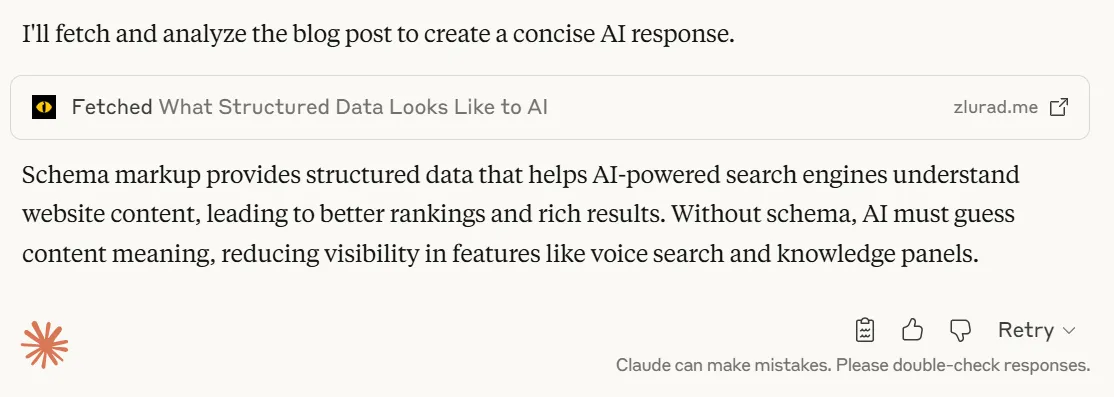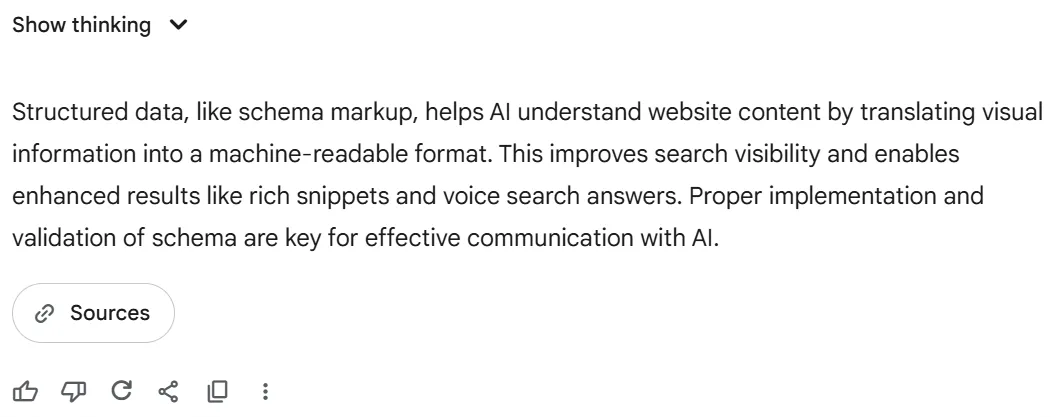In AI-driven results, every word of your content summary has to earn its place. When it appears in an AI Overview or a ChatGPT answer, you have seconds and just a few sentences to get your message across. So we tested whether AI could take our blog post on structured data and AI and turn it into a short, accurate AI response ready for AI-powered search features.
What We Tested
AI Overviews take up 42% of the screen on desktop and 48% on mobile, pushing organic results far down the page. It’s no surprise that many sites are reporting traffic drops from Google. In this crowded, AI‑first space, the quality of an AI response can decide whether your content is seen at all.
We wanted to know if generative AI could write a summary that works in these conditions: short enough to fit the format, accurate enough to trust, and clear enough to win the click.
The Prompt
We gave each AI model the same clear instructions:
Based on the blog post provided, write a concise and informative AI response that could be featured in a Google AI Overview or returned as a direct answer in ChatGPT. The AI response should:
- Be no longer than 350 characters, including spaces.
- Clearly and accurately summarize the main points.
- Avoid filler, vague statements, or promotional language.
Use plain language and a neutral, professional tone.
Return only the AI response with no introductions, explanations, or formatting.
The Results
We ran the prompt through five leading AI models to see how each would handle the challenge of creating a concise, search‑ready AI response. Each tool delivered outputs that could be used with some degree of editing, but they differed in tone, clarity, and approach.
ChatGPT-4o

ChatGPT-4o produced a clear, well‑structured AI response that balanced technical detail with readability. It stayed within the character limit and used precise language, though it leaned slightly more toward explanation than pure summarization.
ChatGPT o4-mini

ChatGPT o4‑mini gave a direct, actionable AI response with strong technical accuracy. The output was slightly denser and more instructional in tone, which made it read more like advice than a neutral summary.
Claude Sonnet 4

Claude Sonnet 4 created a concise, well‑organized AI response that clearly explained the schema’s role in AI‑powered search. It met length requirements and was easy to follow, but leaned toward a formal tone that felt less dynamic than others.
Gemini 2.5 Flash

Gemini 2.5 Flash delivered a straightforward AI response centered on practical application and SEO benefits. It was clear and approachable, though a touch more promotional in tone and less nuanced than other outputs.
Gemini 2.5 Pro

Gemini 2.5 Pro produced a detailed AI response with a good mix of explanation and benefits. Clear and accurate, but slightly longer than ideal and more formal in tone, which could make it feel less conversational in an AI Overview.
The Verdict
This test showed that while every model can produce an AI response that’s technically correct, “usable” isn’t the same as “ready to publish.” The differences came down to tone, clarity, and how well each condensed the main ideas without losing meaning.
For this specific scenario, a short, neutral AI Overview summary, Claude Sonnet 4, and ChatGPT 4o required the least editing. Other models leaned more toward instructional or benefit‑driven language, which may work for certain audiences but could need refinement for a search‑neutral setting.
The takeaway? An AI response can start with the tool, but it needs a human pass to fine‑tune the message, match the brand voice, and ensure it works for both algorithms and readers.
Zlurad PoV
A clean, well‑structured AI response is like a perfectly wrapped gift with not much inside. It technically works, but nobody remembers it. In a SERP where AI Overviews eat half the screen, “technically fine” isn’t enough. Those few lines are prime real estate, and you can either blend in or stand out.
Here’s what we mean:
AI output: “AI-powered search now focuses on understanding meaning, not keywords. Without a clear structure---like headings, lists, hierarchy, and schema markup---AI may misinterpret or ignore content. Well-formatted, segmented writing plus schema markup makes it easier for AI to extract, interpret, and represent your content accurately.”
Our version: “AI search reads between the lines, literally. Without a clear structure, it guesses, skips, or gets you wrong. Headings, lists, hierarchy, and schema markup turn guesswork into certainty, making it easy for AI to lift, understand, and show your content where it counts.”
AI cut it down, but we shaped it into something with voice, purpose, and edge. Because in an AI‑first search world, forgettable content is invisible content.
What Say We?
If you want safe, publish it as‑is.
If you want attention, refine it until it stands out.